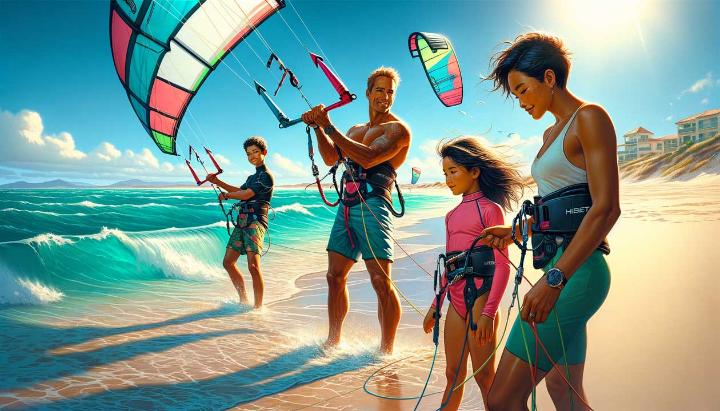Soaring through the skies or carving across the waves, few experiences offer the exhilaration of kite flying or kiteboarding. But beneath the thrill lies a crucial element that can make or break your adventures: the line that connects you to your airborne companion. Choosing the right line, or aircraft cable, is a decision that demands careful consideration – a delicate balance between strength, durability, and handling characteristics that can spell the difference between unforgettable moments and heart-stopping mishaps.
In this comprehensive guide, we'll delve into the world of aircraft cables, exploring the nuances that separate the merely adequate from the exceptional. From stainless steel behemoths to cutting-edge synthetic fibers, we'll unravel the mysteries of each material, revealing the strengths and limitations that make them suited for particular applications. Whether you're a seasoned kite flyer or a thrill-seeking kiteboarder, this knowledge will empower you to make informed decisions, ensuring that your line is a trusted ally, not a weak link.
But material composition is just the beginning. We'll also examine the intricate factors that determine an aircraft cable's performance, from tensile strength and fatigue resistance to weight and flexibility. By understanding these properties, you'll gain the insights needed to choose a line that not only meets your demands but also aligns with your unique style and preferences, whether you crave uncompromising control or value a more forgiving ride.
Understanding the Types of Aircraft Cables for Kite Flying and Kiteboarding
Embarking on the thrilling adventures of kite flying or kiteboarding requires careful consideration of the lines and cables that connect you to your kite or board. These critical components not only determine the performance and control you'll experience but also play a vital role in your safety. With a wide array of options available, it's essential to understand the different types of aircraft cables and their unique characteristics.
Kite Flying Cables: Materials and Construction
When it comes to kite flying, the lines used are typically crafted from natural or synthetic materials like cotton, nylon, or silk. Each material offers its own advantages and drawbacks, allowing you to find the perfect balance between strength, flexibility, and weight for your specific kite flying needs.
- Cotton lines provide a classic feel and are known for their durability and resistance to abrasion. However, they can be heavier and less resistant to moisture compared to synthetic alternatives.
- Nylon lines are lightweight, strong, and offer excellent stretch resistance, making them a popular choice for larger kites that require precise control.
- Silk lines are incredibly lightweight and offer a smooth, luxurious feel. They are often favored by enthusiasts seeking a premium kite flying experience, but they require extra care and maintenance.
Additionally, the construction method plays a crucial role in the performance of kite lines. Braided lines offer superior strength and resistance to tangles, while twisted lines provide more stretch and flexibility, allowing for a wider range of maneuvers.
Kiteboarding Lines: Strength, Flexibility, and Safety

In the adrenaline-fueled world of kiteboarding, safety and durability are paramount. This is where aircraft cables truly shine, offering exceptional strength and resistance to the immense forces encountered on the water. Steel wire ropes or aircraft cables are the go-to choice for kiteboarding lines, as they can withstand the extreme conditions and high tensions involved in this thrilling sport.
These specialized cables are often constructed with multiple strands of high-tensile stainless steel wire, expertly woven together to create a robust and flexible line. The construction methods used, such as braiding or paralleling, can further enhance the cable's performance by improving its resistance to abrasion, kinking, and other potential hazards.
Safety is of utmost importance when using kiteboarding lines, and regular inspections and maintenance are essential. Industry standards and regulations provide guidelines for proper line care, replacement intervals, and safety practices to ensure a secure and enjoyable experience on the water.
Whether you're a seasoned kite flyer or an adrenaline-seeking kiteboarder, understanding the different types of aircraft cables and their unique properties is crucial for choosing the right line for your specific needs. By carefully considering factors such as strength, flexibility, weight, and construction, you can unlock the full potential of your chosen aerial sport while prioritizing safety and performance.
Material Properties and Performance Characteristics of Cable Aircraft
When selecting the right aircraft cable for your kite flying or kiteboarding adventures, understanding the material properties and performance characteristics is crucial. These factors directly impact the cable's strength, durability, and overall safety, ensuring a reliable and enjoyable experience on the water or in the skies.
Common Materials Used in Aircraft Cables
The two primary materials used in aircraft cables are galvanized steel and stainless steel. Each of these materials offers unique advantages and considerations:
- Galvanized Steel Cables are coated with a protective layer of zinc, providing excellent corrosion resistance and durability. These cables are known for their exceptional strength-to-weight ratio and affordability, making them a popular choice for various applications.
- Stainless Steel Cables are highly resistant to corrosion and oxidation, thanks to their chromium content. While slightly more expensive than galvanized steel, stainless steel cables offer superior tensile strength and fatigue resistance, making them ideal for demanding environments or high-stress applications.
In specialized cases, other materials like Dyneema, Spectra, Kevlar, or polyethylene may be used for aircraft cables, each offering its own set of properties tailored to specific requirements.
Key Properties and Characteristics of Aircraft Cables
When evaluating aircraft cables, several key properties and characteristics must be considered to ensure optimal performance and safety:

- Tensile Strength and Breaking Strain refer to the cable's ability to withstand pulling forces without breaking. Higher tensile strength ensures the cable can handle the immense forces encountered during kite flying or kiteboarding.
- Fatigue Strength determines the cable's resistance to cyclic loading, which is essential for applications involving repeated stress and strain.
- Ductility measures the cable's ability to deform plastically before breaking, providing valuable flexibility and preventing sudden failures.
- Brinell Hardness indicates the cable's surface hardness, which affects its resistance to abrasion, wear, and indentation.
- Resistance to Abrasion and UV Damage is crucial for aircraft cables exposed to harsh environments, ensuring long-lasting performance and durability.
- Stretch and Elasticity properties determine the cable's ability to elongate under load and return to its original length, impacting handling characteristics and control.
- Weight and Diameter are essential considerations for optimizing performance, maneuverability, and overall handling in kite flying or kiteboarding.
Understanding these material properties and performance characteristics will help you make an informed decision when selecting the ideal aircraft cable wire for your specific needs, ensuring a safe and thrilling experience every time you take to the skies or waters.
Selecting the Ideal Aircraft Cable Wire for Your Needs
In the demanding world of aviation, aerospace, and engineering, selecting the right aircraft cable wire is a critical decision that can have far-reaching consequences. These specialized cables are the backbone of numerous applications, from aircraft control systems to industrial machinery and beyond. They must be able to withstand extreme conditions, immense forces, and constant wear, all while ensuring optimal performance and unwavering safety.

Choosing the right aircraft cable wire is a meticulous process that requires a thorough understanding of the application's requirements, as well as the material properties and performance characteristics of the available options. It's a decision that can quite literally mean the difference between success and failure, safety and risk.
Key Factors to Consider When Choosing Aircraft Cable Wire
- Strength and Breaking Strain: The cable's ability to withstand pulling forces without breaking is paramount. Higher tensile strength ensures the cable can handle the immense forces encountered in various applications, from kite flying to heavy machinery.
- Corrosion Resistance: Cables are often exposed to harsh environments, making corrosion resistance a critical factor. Stainless steel cables offer superior protection against corrosion and oxidation compared to galvanized steel, making them ideal for demanding applications.
- Cost and Maintenance Considerations: While initial cost is important, it's crucial to factor in long-term maintenance and replacement costs. A higher upfront investment in a more durable cable can pay dividends in the long run by reducing downtime and associated costs.
- Weight and Diameter: The cable's weight and diameter can significantly impact performance, maneuverability, and overall handling. Striking the right balance between strength and weight is essential, especially in weight-sensitive applications like aircraft control systems.
- Flexibility and Fatigue Resistance: Cables must be able to bend and flex without compromising integrity, while also withstanding repeated stress and strain. Fatigue resistance is crucial in applications involving cyclic loading, ensuring the cable doesn't fail prematurely.
- Temperature Resistance: Depending on the operating environment, temperature resistance may be a critical consideration. Cables must be able to maintain their properties and performance within the specified temperature range.
By carefully evaluating these key factors and considering the specific requirements of your application, you can make an informed decision and select the ideal aircraft cable wire that meets your needs for strength, durability, and overall performance.
Understanding Wire Rope Construction and Specifications
Beyond the material composition, it's essential to understand the intricacies of wire rope construction and specifications. These details can significantly impact the cable's performance characteristics and suitability for various applications.
Wire ropes are typically constructed with multiple strands of individual wires, each with its own unique configuration. Common configurations include 7x19 (seven strands with 19 wires per strand) and 7x7 (seven strands with seven wires per strand), among others. The choice of configuration can affect factors like flexibility, resistance to abrasion, and overall strength.
Additionally, wire rope specifications detail crucial information such as diameter, construction type, grade, and core type (fiber core, independent wire rope core, etc.). These specifications provide a comprehensive understanding of the cable's capabilities and limitations, allowing you to make an informed selection that aligns with your specific requirements.
- Consult with experts
- Understand industry standards
- Ensure proper installation and maintenance
While selecting the right aircraft cable wire may seem daunting, it's a process that can be streamlined by consulting with experts, understanding industry standards and regulations, and ensuring proper installation and maintenance practices. By taking a comprehensive approach and considering all relevant factors, you can make an informed decision that not only meets your performance requirements but also prioritizes safety and reliability.
Remember, when it comes to aircraft cable wire, there's no room for compromise. The right choice can mean the difference between a successful operation and a catastrophic failure. Embrace the challenge, weigh your options carefully, and select the cable that will propel your application to new heights of performance and safety. For additional insights on how to enhance your aerial sports gear, discover the benefits of nylon and Dyneema cordage. If your needs extend beyond kite flying and kiteboarding, explore our customization options to tailor cables that meet your specific requirements.
Need Expert Guidance on Aircraft Cables?
Kite flying and kiteboarding enthusiasts must carefully select the right aircraft cable to ensure safety and optimal performance. Material selection is crucial, with options like stainless steel, Dyneema, Spectra, and Kevlar, each offering distinct advantages in strength, durability, and resistance to environmental factors. Consider the intended use, required strength, handling characteristics, and budget when choosing your aircraft cable wire. By understanding these critical factors and aligning them with your specific needs, you can enhance your aerial or waterborne adventures efficiently and safely.